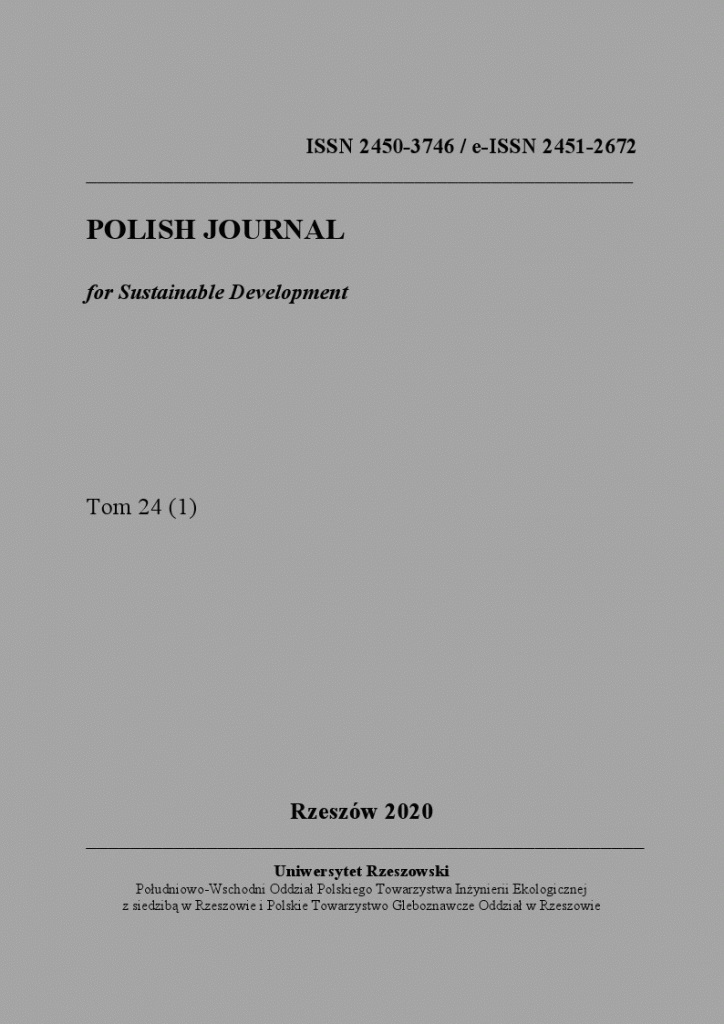Rain gardens as a way of retarding loss of waste water in urban green areas
DOI:
https://doi.org/10.15584/pjsd.2020.24.1.2Keywords:
small retention, bioretention, rain gardens, hydrotechnical building, balanced drainage systemAbstract
Rain gardens are one of the simplest and highly effective ways to manage rainwater. Founded in the ground or in a container, contrary to appearances, they resemble "ordinary gardens", However, thanks to carefully selected species of hydrophyte plants, they become a natural water reservoir, especially in urban green areas. In many European countries and the US, research and design of rain gardens is one of the most current tasks of spatial planning and landscape architecture. Also in Poland in recent years it has been decided to implement this type of hydrotechnical buildings in the urban landscape. They arise on the citizens' initiative or are part of the commune budget. Regardless of the source of funding, they form the core of activities related to adaptation to climate change and slowing down the loss of rainwater in urban areas.
Downloads
References
Biała I. 2020. Zatrzymać deszcz tam, gdzie spadł – coraz więcej miejscowej retencji w Gdańsku. [dok. elektr.: www.zielonainfrastruktura.pl/zatrzymac-deszcz-tam-gdzie-spadl-coraz-wiecej-miejscowej-retencji-w-gdansku/; data wejścia: 4.05.2020].
Bogacz A., Woźniczka P., Burszta-Adamiak E., Kolasińsk E. 2013. Metody zwiększania retencji wodnej na terenach zurbanizowanych. Przegląd Naukowy – Inżynieria i Kształtowanie Środowisk. 59. 27-35.
Bortolini L., Zanin G. 2018. Hydrological behaviour of rain gardens and plant suitability: A study in the Veneto plain (north-eastern Italy) conditions. Urban Forestry & Urban Greening 34. 121-133.
Chaffin B. C., Shuster W. D., Garmestani A. S., Furio B., Albro S. L., Gardiner M., Spring M., Odom Green O. 2016. A tale of two rain gardens: Barriers and bridges to adaptive management of urban stormwater in Cleveland, Ohio. Journal of Environmental Management. 183. 431-441.
Dall’Ara E., Maino E., Gatta G., Torreggiani D., Tassinari P. 2019. Green Mobility Infrastructures. A landscape approach for roundabouts’ gardens applied to an Italian case study. Urban Forestry & Urban Greening. 37. 109-125.
Długozima A. 2009. Ogrody deszczowe. Problemy Ekologii. 13(4). 211-215.
Domanowska M., Kostecki J. 2015. Ogrody deszczowe w miastach jako jedno z narzędzi wdrażania usług ekosystemów. Zeszyty Naukowe Uniwersytetu Zielonogórskiego. 158. 50-58.
Dong Won Shin, McCann L. 2018. Analyzing differences among non-adopters of residential stormwater management practices. Landscape and Urban Planning. 178. 238-247.
Ebrahimian A., Wadzuk B., Traver R. 2019. Evapotranspiration in green stormwater infrastructure systems. Science of the Total Environment. 688. 797-810.
E-katalog roślin. [dok. elektr.: www.e-katalogroslin.pl; data wejścia: 4.05.2020].
Fundacja Sendzimira. Warszawa chwyta wodę. 2018. [dok. Elektr.: https://sendzimir.org.pl/projekty/warszawa-chwyta-wode/; data wejścia: 4.05.2020].
Fundacja Sendzimira. Ogród deszczowy w gruncie. 2019a. [dok. Elektr.: https://sendzimir.org.pl/wp-content/uploads/2019/03/broszura-ogrod-deszczowy-w-gruncie.pdf; data wejścia: 4.05.2020].
Fundacja Sendzimira. Ogród deszczowy w pojemniku. 2019b. [dok. Elektr.: https://sendzimir.org.pl/wp-content/uploads/2019/03/broszura-ogr%C3%B3d-deszczowy-w-pojemniku.pdf; data wejścia: 4.05.2020].
Gdańskie Wody. Gdańska Polityka Malej Retencji Miejskiej. 2019. [dok. Elektr.: www.gdmel.pl; data wejścia: 4.05.2020].
Kamińska M. 2020. Miejskie retencjonowanie wód opadowych. [dok. Elektr.: www.uslugiekosystemow.pl/2019/11/29/miejskie-retencjonowanie-wod-opadowych; data wejścia: 31.03.2020].
Kosmala M., 2003. Ogrody deszczowe czyli ogrody retencjonujące wody opadowe – moda czy konieczność, [w:] Myga-Piątek U. (red.) Woda w przestrzeni przyrodniczej i kulturowej, Prace Komisji Krajobrazu Kulturowego PTG. 2. 205-274.
Kostecka J. 2017. Odniesienia koncepcji retardacja przekształcania zasobów przyrody do wybranych aktów prawnych w kontekście budowania zrównoważonego rozwoju i gospodarki o obiegu zamkniętym. Inżynieria Ekologiczna. 18. 6. 1-15. DOI: 10.12912/23920629/79430.
Miejskie Plany Adaptacji. Wczuj się w klimat!. 2019. [dok. elektr.: www.44mpa.pl; data wejścia: 4.05.2020].
Papafotiou E., Katsifarakis K.L. 2015. Ecological Rainwater Management in Urban Areas. Preliminary Considerations for the city of Corinth, Greece. Agriculture and Agricultural Science Procedia. 4. 383-391.
Stec A., Dziopak J. 2017. Woda deszczowa w architekturze krajobrazu nowoczesnych miast. Czasopismo Inżynierii Lądowej, Środowiska i Architektury Journal of Civil Engineering. Environment and Architecture JCEEA. XXXIV. 64. 315-333.
Stop suszy. Wody Polskie popierają aktywne przeciwdziałanie suszy na wsi i w mieście. 2020. [dok. elektr.: www.stopsuszy.pl; data wejścia: 4.05.2020].
Szpakowski W., Royss J., Lademann D. 2018. Ogród deszczowy w 5 krokach. Gdański Poradnik Małej Retencji. Wyd. Gdańskie Wody. Gdańsk.
Vaculová V., Fuska J. 2017. Rain gardens – case study of potential locations identification using GIS. Acta Sci. Pol. Formatio Circumiectus. 16 (2). 217-230.
Yuan J., Dunnett N. 2018. Plant selection for rain gardens: Response to simulated cyclical flooding of 15 perennial species. Urban Forestry & Urban Greening. 35. 57-65.
Downloads
Published
Issue
Section
License
Copyright (c) 2020 Polish Journal for Sustainable Development

This work is licensed under a Creative Commons Attribution-NonCommercial-NoDerivatives 4.0 International License.


